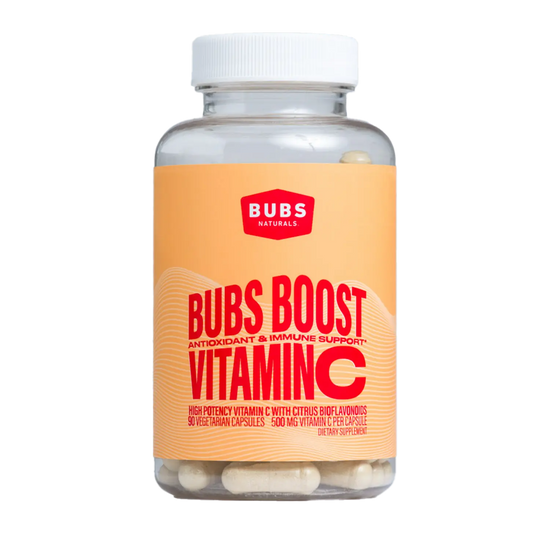Table of Contents
- Introduction
- The Science Behind Oxidation
- Recognizing Oxidized Vitamin C
- Best Practices to Preserve Vitamin C Stability
- Conclusion
When it comes to skincare, few ingredients have garnered as much attention as vitamin C. Renowned for its brightening properties and antioxidant benefits, this powerhouse is a staple in our beauty regimens. However, the efficacy of vitamin C can be influenced significantly by its stability. A pivotal concern that many individuals encounter is: how long does it take for vitamin C to oxidize? Understanding this can enhance how we incorporate vitamin C into our routines, maximizing its potential benefits.
At BUBS Naturals, where we believe in living an adventurous and wellness-driven lifestyle, we aim to empower our community with actionable, science-backed knowledge. This blog post will delve into the intricacies of vitamin C oxidation, its implications on product effectiveness, and how to maintain its stability with practical tips.
Introduction
Did you know that as soon as vitamin C is exposed to air, light, and heat, it begins a race against time before it becomes less effective? If that sounds alarming, you're not alone. Vitamin C, or L-ascorbic acid, is a delicate compound, highly valuable in skincare yet notoriously unstable. The oxidation process can lead to diminished potency, which leaves many wondering if their pricey serums are still working after just a few weeks.
Understanding the mechanics of vitamin C oxidation is essential for anyone looking to reap its benefits effectively. In this post, we will cover the following key areas:
- What oxidation is and how it affects vitamin C.
- How long it typically takes for vitamin C to oxidize.
- Signs that indicate your vitamin C product has oxidized.
- Best practices for prolonging the freshness and efficacy of vitamin C products.
This exploration isn’t just about highlighting a scientific process; it’s about empowering you to make informed decisions regarding your skincare. With a better understanding of vitamin C stability, we can confidently enrich our routines and maximize our radiant glow.
The Science Behind Oxidation
Oxidation in chemical terms refers to a reaction involving the transfer of electrons, often resulting in the degradation of compounds. For vitamin C, oxidation occurs when it interacts with oxygen, leading to a process that transforms it into dehydroascorbic acid (DHA) and eventually into other byproducts. This not only reduces the effectiveness of the vitamin but can also alter the product's color and scent.
The Speed of Oxidation
So, how long does it take for vitamin C to oxidize? Research shows that vitamin C can start the oxidation process almost immediately upon exposure to air. For L-ascorbic acid in serum form:
- First 15 Minutes: Initial oxidation can commence within minutes, particularly in the presence of metal ions, such as copper found in some water systems. A study indicated that 35% of vitamin C can be oxidized just 15 minutes after exposure to typical contaminants.
- After 1 Hour: Within a couple of hours, nearly 80-90% of vitamin C in an exposed serum may oxidize, significantly reducing its efficacy.
Key Factors Influencing Oxidation
Several variables can accelerate or slow down the oxidation process:
- Exposure to Air: Whenever the bottle is opened, oxygen interacts with the product, prompting oxidation.
- Light: UV light exposure can trigger rapid decomposition of vitamin C, which is why many products are packaged in opaque or dark containers.
- Temperature: Higher temperatures can speed up the degradation process, making it essential to store vitamin C serums in cool places.
- pH Levels: L-ascorbic acid is most effective at a pH level of 3.5. Products formulated outside this range may oxidize quicker.
Recognizing Oxidized Vitamin C
It’s crucial to understand how to determine whether your vitamin C has gone bad. Here are some telltale signs:
- Color Change: Fresh vitamin C typically appears clear or light yellow. If it transitions to a darker yellow, orange, or brown, it has likely oxidized.
- Smell: An off or sour odor can also indicate degradation.
- Texture: If the product has developed an unusual consistency or viscosity, it may be a sign of oxidation.
Even after oxidation, using vitamin C is not harmful; however, the benefits will be significantly reduced. Instead of a powerful antioxidant, you may be applying a compound that does little more than contribute to your skin routine.
Best Practices to Preserve Vitamin C Stability
Now that we understand the risks of oxidation, let's look at effective methods to extend the shelf life and efficacy of our vitamin C products.
1. Choose Quality Products
Opt for high-quality vitamin C formulations with stabilizing ingredients such as vitamin E or ferulic acid, which help protect against oxidation. Look for:
- Opaque Packaging: Dark or opaque containers limit light exposure.
- Airless Pumps: These reduce air access significantly, keeping the product fresh longer.
2. Store Properly
Storing your vitamin C products right can make a world of difference:
- Cool, Dark Location: Keep your serums in a refrigerator or a dark drawer to avoid light and heat.
- Seal Tightly: Always close caps securely after use to limit air exposure.
3. Monitor Expiration Dates
Every vitamin C serum will eventually expire. Manufacturers usually indicate a “period after opening” (PAO), which details how long the product remains stable after first use—typically around 3 to 6 months.
4. Don’t Over-Stock
Rather than buying products in bulk, which increases the likelihood of using oxidized products, consider purchasing smaller quantities that you can use more frequently.
5. Watch for Changes
Monitor your products regularly for changes in color, scent, or texture and follow best practices for disposal if you notice they have oxidized.
Conclusion
As we unpacked the intricacies of vitamin C oxidation, we reinforced the importance of understanding how to maintain its potency and efficacy. From recognizing the signs of oxidation to implementing best practices, being proactive with your vitamin C products not only enhances your skincare routine but also empowers you to make healthier lifestyle choices.
By controlling external factors and selecting quality formulations, we ensure that we’re gaining the maximum benefit from vitamin C, contributing to our goal of holistic wellness—one radiant glow at a time.
FAQ
How can I tell if my vitamin C serum is still good?
If your vitamin C serum has changed color to a darker shade, developed an off smell, or has an unusual texture, these are good indicators that it has oxidized and may no longer be effective.
Is it safe to use oxidized vitamin C?
Using oxidized vitamin C is not harmful, but its benefits for skin health will be diminished.
How long does vitamin C last in an opened bottle?
Typically, vitamin C serums last between 2-4 months after opening, depending on the formulation and storage method.
Can I still use vitamin C after it turns yellow?
While it may still be safe to use, once vitamin C begins to oxidize, its potency decreases significantly, meaning you may not experience the expected benefits.
By integrating this knowledge into our routines, we can approach skincare with confidence and purpose, fully embracing our wellness journeys together. At BUBS Naturals, we’re committed to supporting each step of your wellness adventure with clean, functional supplements that empower you to thrive. As always, let’s continue to explore, educate, and elevate our well-being—because life is too vibrant to settle for anything less.
Written by:
Bubs Naturals

Vitamin C
Starts at $20.00
Shop

